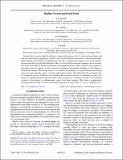Biofilm Growth and Fossil Form
Author(s)
Beukes, N. J.; Rothman, Daniel H.; Bosak, Tanja; Petroff, Alexander Peter
DownloadBosak_Biofilm growth.pdf (1.835Mb)
PUBLISHER_CC
Publisher with Creative Commons License
Creative Commons Attribution
Terms of use
Metadata
Show full item recordAbstract
Stromatolites can grow under the influence of microbial processes, but it is often unclear whether and how the macroscopic morphology of these rocks records biological processes. Conical stromatolites, which formed in the absence of sedimentation, provide a comparatively simple record of the interplay between microbial growth and lithification. Here, we show that the dynamics shaping conical stromatolites result from diffusive gradients within the overlying microbial mat. These gradients cause minerals to precipitate faster in regions of high curvature, resulting in measurable properties of the shapes of stromatolite laminas. This model allows us to estimate the thickness of ancient stromatolite-forming mats to be approximately 1 mm, consistent with modern systems. Proceeding from the assumption that the ubiquitous process of diffusion is recorded in the translating form of a stromatolite, we derive the shape of a diffusion-driven stromatolite. The conical morphology—a distinctive feature of stromatolites growing in the absence of sedimentation—arises from these dynamics. This form is quantitatively consistent with the shape of conical stromatolites that grew for more than 2.9×10[superscript 9] yrs of Earth history.
Date issued
2013-11Department
Lorenz Center (Massachusetts Institute of Technology)Journal
Physical Review X
Publisher
American Physical Society
Citation
Petroff, A. P., N. J. Beukes, D. H. Rothman, and T. Bosak. “Biofilm Growth and Fossil Form.” Physical Review X 3, no. 4 (November 2013).
Version: Final published version
ISSN
2160-3308